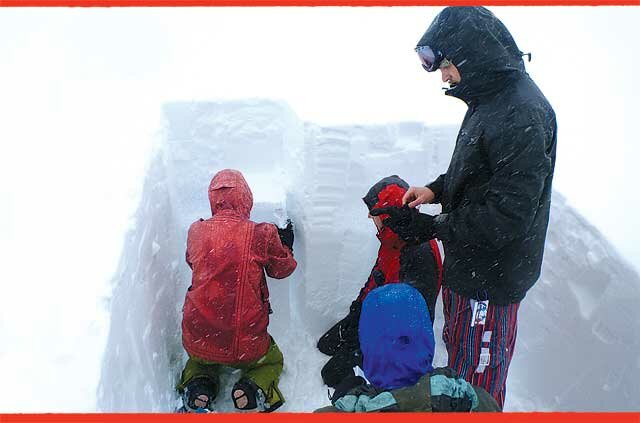 |
| Story by Pat Grubb Photos by Louise MugarIt’s pretty simple, actually. There’s only one thing you need to know about avalanches and this Here’s a sobering thought: Avalanches are rated on a five-point scale, D1 to D5. Only D1 is considered too small to injure or bury someone. D2 to D5? Think last will and testament. Not convinced? A cubic yard of Baker crud can weigh close to a ton – how do you think you’d feel after a spin cycle down the hill with three or four hundred of those? Better? Or worse? None of this is news to those who follow the news – every year we read about skiers, snowboarders or snowmobilers killed while venturing outside of ski areas. Why do they risk it? If you asked the outdoor enthusiasts taking the Level 1 Avalanche course from the American Alpine Institute (AAI) last season, you’d get a variety of answers. Mostly college students, their answers ranged from “can’t afford tickets,” “dude, it’s the pow,” “no crowds,” to “the challenge.” All good reasons but there is one more that has to be seen to be believed – the ineffable beauty of snowy peaks under cerulean skies will fill your soul to completeness, and you will never be the same again. (OK, just kidding about the ineffable cerulean stuff.)
How do you avoid becoming a statistic? Prove that you’re smarter than you look – take an avalanche awareness course. AAI has gained worldwide fame for its expertise on all aspects of mountain adventuring but Mt. Baker Ski Area and others also offer avalanche awareness courses. In AAI’s avalanche training (AIARE Level 1), participants will learn how to recognize and avoid avalanche terrain, observe and analyze snow conditions over time, conduct field tests and observations, and plan and prepare for travel in avalanche terrain. AAI instructor Richard Riquelme, probably the coolest Chilean souvenir ever to land on American shores, starts his class by asking students to line up alphabetically by name. The only catch is, you aren’t allowed to speak. Try it sometime with a group of strangers. His point? The need, ability and importance of communicating in avalanche terrain. In fact, human factors are usually more important than the physical environment when it comes to safely traversing the backcountry. AAI courses combine classroom instruction with two days in the backcountry. The course uses material developed by the American Institute for Avalanche Research and Education and aims to provide the student with the knowledge and decision-making skills that will keep him or her safe in avalanche terrain. WET SNOW. The course explains the different types of avalanches, such as loose wet snow or slab avalanches. The first type tends to move slower but is difficult to escape as the snow takes on the consistency of wet cement. Slab avalanches happen when the snowfield breaks as one cohesive unit before splitting up into progressively smaller chunks. A skier only has the first few seconds while the slab is gliding to ski off to the side before the unit breaks up. Most fatalities involve slab avalanches. Participants learn the process of backcountry decision-making: Understanding the dangers, recognizing and anticipating the human factors, creating terrain options and planning for emergency responses. Of these, the human factors are perhaps the most insidious dangers of all. A review of avalanches in the U.S. during the 1990s showed that terrain, weather and snowpack conditions contributed to fatal avalanche accidents, but human factors were the primary cause. Such factors include social pressure, overconfidence or low self-confidence, closed-mindedness, shortcutting and impaired objectivity. You see your buddies traversing across a slope so it must be OK? That’s social pressure. A phenomenon known as ‘risky shift’ occurs when a group accepts a higher level of risk than what each individual might choose alone. Interestingly, young men will tend to accept higher risks if there are women in the group. Low self-confidence will lead someone to mistrust their instincts and to accept a decision they intuitively feel is wrong. Additionally, such people may be hesitant to question someone with greater experience even if they have information that the leader does not. ON THE MOUNTAIN. The backcountry days are where you put all your newfound knowledge to work. You’ll conduct a snow profile, test the stability of the snowpack and compare local conditions to avalanche bulletins. Finally, you’ll learn how to conduct a search using avalanche transceivers and probes. Once someone is buried, time becomes critical. A 2011 Canadian study showed survival times are much shorter than what had previously been thought. If the victim hasn’t suffered trauma, they have only a 78 percent chance of surviving burial for 10 minutes or less. Only 40 percent survive at 15 minutes and it drops fast after that. In moist maritime snow conditions (remind you of anywhere?), survival times are even lower. A sobering thought: Riquelme told class members that it was very likely that they would be the most knowledgeable person in whatever group that was headed into the backcountry. Knowing that, you’ll want to make sure that you’re prepared for the backcountry, you take the courses, or make sure you know the competency of everyone in your group. To learn more about the American Alpine Institute (AAI), visit alpineinstitute.com or call 360/671-1505. Mt. Baker Ski Area offers two courses in their mountain education center beginning in December. Go to mtbaker.us or call 360/734-6771. X
|